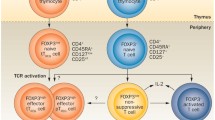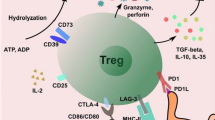Abstract
There is considerable evidence of a key role for CD4+ T cells in the pathogenesis of rheumatoid arthritis. Several attractive candidate antigens, mostly joint-specific, have been studied, but information regarding T cell responses to these antigens in patients is limited and occasionally contra-dictory. Novel reagents (such as major histocompatibility complex and peptide tetramers) and sensitive techniques (such as intracellular cytokine staining) will aid in future studies to identify antigen-specific T cells. In addition, a new animal model of inflammatory arthritis has recently pro-vided new perspective to the study of rheumatoid arthritis by drawing attention to systemic self-antigens as targets of autoimmunity and anti-self antibodies as markers of T cell activity and effectors of disease.
Similar content being viewed by others
References and Recommended Reading
Marrack P, Kappler J, Kotzin BL: Autoimmune disease: why and where it occurs. Nat Med 2001, 7:899–905.
Notkins AL, Lernmark A: Autoimmune type 1 diabetes: resolved and unresolved issues. J Clin Invest 2001, 108:1247–1252.
Matsumoto I, Staub A, Benoist C, Mathis D: Arthritis provoked by linked T and B cell recognition of a glycolytic enzyme. Sci-ence 1999, 286:1732–1735. This paper provides definitive evidence that GPI is the target antigen in the K/BxN mouse model of arthritis and that anti-GPI antibodies alone are sufficient to cause a destructive arthritis. This mouse model has important implications for the type of autoantigen (systemic) that could stimulate arthritis and for the potential role of autoantibodies in the development of arthritis.
Wipke BT, Allen PM: Essential role of neutrophils in the initi-ation and progression of a murine model of rheumatoid arthritis. J Immunol 2001, 167:1601–1608. This study elucidates the effector mechanisms by which anti-GPI anti-bodies cause disease in the K/BxN mouse model.
Lehmann PV, Sercarz EE, Forsthuber T, et al.: Determinant spreading and the dynamics of the autoimmune T-cell reper-toire. Immunol Today 1993, 14:203–208.
Nepom GT: Major histocompatibility complex-directed sus-ceptibility to rheumatoid arthritis. Adv Immunol 1998, 68:315–332.
Gregersen PK, Silver J, Winchester RJ: The shared epitope hypothesis: an approach to understanding the molecular genetics of susceptibility to rheumatoid arthritis. Arthritis Rheum 1987, 30:1205–1213.
Kohem CL, Brezinschek RI, Wisbey H, et al.: Enrichment of dif-ferentiated CD45RBdim, CD27-memory T cells in the periph-eral blood, synovial fluid, and synovial tissue of patients with rheumatoid arthritis. Arthritis Rheum 1996, 39:844–854.
Choy EH, Panayi GS: Cytokine pathways and joint inflamma-tion in rheumatoid arthritis. N Engl J Med 2001, 344:907–916.
Schmidt D, Goronzy JJ, Weyand CM: CD4+ CD7-CD28- T cells are expanded in rheumatoid arthritis and are characterized by autoreactivity. J Clin Invest 1996, 97:2027–2037.
Ali M, Ponchel F, Wilson KE, Francis MJ, et al.: Rheumatoid arthritis synovial T cells regulate transcription of several genes associated with antigen-induced anergy. J Clin Invest 2001, 107:519–528.
O’Garra A, Steinman L, Gijbels K: CD4+ T-cell subsets in autoimmunity. Curr Opin Immunol 1997, 9:872–883.
Feldmann M, Brennan FM, Maini RN: Rheumatoid arthritis. Cell 1996, 85:307–310.
Miossec P: Interleukin-17 in rheumatoid arthritis: if T cells were to contribute to inflammation and destruction through synergy. Arthritis Rheum 2003, 48:594–601.
Koetz K, Bryl E, Spickschen K, et al.: T cell homeostasis in patients with rheumatoid arthritis. Proc Natl Acad Sci U S A 2000, 97:9203–9208.
Altman JD, Moss PA, Goulder PJ, et al.: Phenotypic analysis of antigen-specific T lymphocytes. Science 1996, 274:94–96.
Crawford F, Kozono H, White J, et al.: Detection of antigen-specific T cells with multivalent soluble class II MHC cova-lent peptide complexes. Immunity 1998, 8:675–682.
Meyer AL, Trollmo C, Crawford F, et al.: Direct enumeration of Borrelia-reactive CD4 T cells ex vivo by using MHC class II tetramers. Proc Natl Acad Sci U S A 2000, 97:11433–11438.
Kotzin BL, Falta MT, Crawford F, et al.: Use of soluble peptide-DR4 tetramers to detect synovial T cells specific for cartilage antigens in patients with rheumatoid arthritis. Proc Natl Acad Sci U S A 2000, 97:291–296. This study demonstrates the potential utility of both MHC class II tet-ramers and TCR transfected hybridomas as reagents for the study of antigen-specific T cell responses in RA.
Maino VC, Picker LJ: Identification of functional subsets by flow cytometry: intracellular detection of cytokine expres-sion. Cytometry 1998, 34:207–215.
Hesse MD, Karulin AY, Boehm BO, et al.: A T cell clone’s avid-ity is a function of its activation state. J Immunol 2001, 167:1353–1361.
Zou J, Zhang Y, Thiel A, et al.: Predominant cellular immune response to the cartilage autoantigenic G1 aggrecan in anky-losing spondylitis and rheumatoid arthritis. Rheumatology 2003, 42:1–10.
Fontenot AP, Canavera SJ, Gharavi L, et al.: Target organ local-ization of memory CD4+ T cells in patients with chronic beryllium disease. J Clin Invest 2002, 110:1473–1482.
Struyk L, Hawes GE, Chatila MK, et al.: T cell receptors in rheu-matoid arthritis. Arthritis Rheum 1995, 38:577–589.
Striebich CC, Falta MT, Wang Y, et al.: Selective accumulation of related CD4+ T cell clones in the synovial fluid of patients with rheumatoid arthritis. J Immunol 1998, 161:4428–4436.
Boen E, Crownover AR, McIlhaney M, et al.: Identification of T cell ligands in a library of peptides covalently attached to HLA-DR4. J Immunol 2000, 165:2040–2047.
Malmstrom V, Michaelsson E, Burkhardt H, et al.: Systemic ver-sus cartilage-specific expression of a type II collagen- specific T-cell epitope determines the level of tolerance and suscepti-bility to arthritis. Proc Natl Acad Sci U S A 1996, 93:4480–4485.
Bäcklund J, Carlsen S, Hℷer T, et al.: Predominant selection of T cells specific for the glycosylated collagen type II epitope (263-270) in humanized transgenic mice and in rheumatoid arthritis. Proc Nat Acad Sci U S A 2002, 99:9960–9965. This study uses mice transgenic for human HLA-DR4, CD4, and CII to show that tolerance for post-translationally modified (glycosylated) CII epitopes may be different than nonmodified epitopes. Additional experiments suggest that RA T cells may predominantly recognize the immunodominant CII epitope in its glycosylated form.
Rosloniec EF, Brand DD, Myers LK, et al.: Induction of autoim-mune arthritis in HLA-DR4 (DRB1-0401) transgenic mice by immunization with human and bovine type II collagen. J Immunol 1998, 160:2573–2578.
Stuart JM, Dixon FJ: Serum transfer of collagen-induced arthritis in mice. J Exp Med 1983, 158:378–392.
Kim HY, Kim WU, Cho ML, et al.: Enhanced T cell proliferative response to type II collagen and synthetic peptide CII (255- 274) in patients with rheumatoid arthritis. Arthritis Rheum 1999, 42:2085–2093.
Verheijden GF, Rijnders AW, Bos E, et al.: Human cartilage gly-coprotein- 39 as a candidate autoantigen in rheumatoid arthritis. Arthritis Rheum 1997, 40:1115–1125.
Cope AP, Patel SD, Hall F, et al.: T cell responses to a human cartilage autoantigen in the context of rheumatoid arthritis-associated and nonassociated HLA-DR4 alleles. Arthritis Rheum 1999, 42:1497–1507.
Hain NA, Stuhlmuller B, Hahn GR, et al.: Biochemical charac-terization and microsequencing of a 205-kDa synovial pro-tein stimulatory for T cells and reactive with rheumatoid factor containing sera. J Immunol 1996, 157:1773–1780.
Blass S, Schumann F, Hain NA, et al.: P205 is a major target of autoreactive T cells in rheumatoid arthritis. Arthritis Rheum 1999, 42:971–980.
Zhang Y, Guerassimov A, Leroux JY, et al.: Arthritis induced by proteoglycan aggrecan G1 domain in BALB/c mice: evidence for t cell involvement and the immunosuppressive influence of keratan sulfate on recognition of T and B cell epitopes. J Clin Invest 1998, 101:1678–1686.
Finnegan A, Mikecz K, Tao P, Glant TT: Proteoglycan (aggre-can)- induced arthritis in BALB/c mice is a Th1-type disease regulated by Th2 cytokines. J Immunol 1999, 163:5383–5390.
Guerassimov A, Zhang Y, Banerjee S, et al.: Cellular immunity to the G1 domain of cartilage proteoglycan aggrecan is enhanced in patients with rheumatoid arthritis but only after removal of keratan sulfate. Arthritis Rheum 1998, 41:1019–1025.
Tighe H, Carson D: Rheumatoid factor. In Kelley’s Textbook of Rheumatology, edn 6. Edited by Ruddy S, Harris E, Sledge C. Philadelphia: W.B. Saunders; 2001:151–160.
Blass S, Union A, Raymackers J, et al.: The stress protein BiP is overexpressed and is a major B and T cell target in rheuma-toid arthritis. Arthritis Rheum 2001, 44:761–771.
Corrigall VM, Bodman-Smith MD, Fife MS, et al.: The human endoplasmic reticulum molecular chaperone BiP is an autoan-tigen for rheumatoid arthritis and prevents the induction of experimental arthritis. J Immunol 2001, 166:1492–1498.
Schellekens GA, Visser H, de Jong BA, et al.: The diagnostic properties of rheumatoid arthritis antibodies recognizing a cyclic citrullinated peptide. Arthritis Rheum 2000, 43:155–163.
Schellekens GA, de Jong BA, van den Hoogen FH, et al.: Citrul-line is an essential constituent of antigenic determinants rec-ognized by rheumatoid arthritis-specific autoantibodies. J Clin Invest 1998, 101:273–281.
Girbal-Neuhauser E, Durieux JJ, Arnaud M, et al.: The epitopes targeted by the rheumatoid arthritis-associated anti-filaggrin autoantibodies are post-translationally generated on various sites of (pro) filaggrin by deimination of arginine residues. J Immunol 1999, 162:585–594.
Masson-Bessiℰe C, Sebbag M, Girbal-Neuhauser E, et al.: The major synovial targets of the rheumatoid arthritis-specific anti-filaggrin autoantibodies are deiminated forms of the alpha- and beta-chains of fibrin. J Immunol 2001, 166:4177–4184. This study characterizes the antigenic targets of anti-filaggrin antibodies, with important implications for the study of relevant Th cell populations.
Fritsch R, Eselböck D, Skriner K, et al.: Characterization of autoreactive T cells to the autoantigens heterogenous nuclear ribonucleoprotein A2 (RA33) and filaggrin in patients with rheumatoid arthritis. J Immunol 2002, 169:1068–1076.
Hong J, Ohmura K, Mahmood U, et al.: Arthritis critically dependent on innate immune system players. Immunity 2002, 16:157–168. Using the K/BxN serum transfer system, this study shows that arthrito-genic anti-GPI antibodies act through Fc receptors and the alternative pathway of complement activation.
Lee DM, Friend DS, Gurish MF, et al.: Mast cells: a cellular link between autoantibodies and inflammatory arthritis. Science 2002, 297:1689–1692. This study shows that mast cells are required for anti-GPI antibody transfer of arthritis, and may be a key cell type mediating joint damage.
Hong J, Pettit A, Ohmura K, et al.: Critical roles for interleukin 1 and tumor necrosis factor-alpha in antibody-induced arthritis. J Exp Med 2002, 196:77–85.
Matsumoto I, Maccioni M, Lee DM, et al.: How antibodies to a ubiquitous cytoplasmic enzyme may provoke joint-specific autoimmune disease. Nat Immunol 2002, 3:360–365. This study demonstrates that extracellular GPI is present on the artic-ular surface and proposes a mechanism explaining the joint-selectiv-ity of the K/BxN arthritis model.
Schaller M, Burton DR, Ditzel HJ: Autoantibodies to GPI in rheumatoid arthritis: linkage between an animal model and human disease. Nat Immunol 2001, 2:746–753. This study suggested that GPI could be an autoantigen in patients with RA, but subsequent studies have not been able to confirm this finding.
Matsumoto I, Lee DM, Goldbach-Mansky R, et al.: Low prevalence of antibodies to glucose-6-phosphate isomerase in patients with rheumatoid arthritis and a spectrum of other chronic autoimmune disorders. Arthritis Rheum 2003, 48:944–954. This study represents several follow-up studies showing that responses to GPI are not specific to patients with RA compared with control individuals.
Albert LJ, Inman RD: Molecular mimicry and autoimmunity. N Engl J Med 1999, 341:2068–2074.
Albani S, Carson DA: A multistep molecular mimicry hypoth-esis for the pathogenesis of rheumatoid arthritis. Immunol Today 1996, 17:466–470.
Author information
Authors and Affiliations
Rights and permissions
About this article
Cite this article
Bennett, S.R., Falta, M.T., Bill, J. et al. Antigen-specific T cells in rheumatoid arthritis. Curr Rheumatol Rep 5, 255–263 (2003). https://doi.org/10.1007/s11926-003-0003-y
Issue Date:
DOI: https://doi.org/10.1007/s11926-003-0003-y




